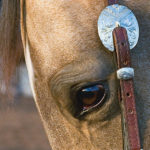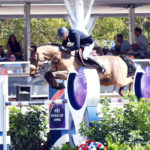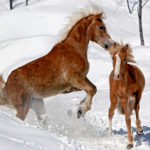The test event for the 2017 FEI World Cup™ Dressage Final, which took place in May 2016, was just a hint of what lies ahead for the discipline in Omaha next spring, when all the stops are pulled out at the state-of-the-art CenturyLink Center, March 29–April 2.
At the test event, dressage riders were impressed both by the facility and the city during last spring’s International Omaha show, where they also offered praise for the organization. Of course, the nine riders who competed in the test event would like to return for the final, but it’s so difficult to qualify that such an ambition is far easier said than done.
Yet there may be a way to fulfill at least part of the dream for dressage riders who don’t make it into the final itself with the addition of the Dressage Showcase, a feature unique to Omaha’s World Cup™ program.
Just as the 2005 finals were ground-breaking when Las Vegas paired the dressage cup with the show jumping cup for the first time, Omaha will mark a new chapter for the discipline. Organizers believe they have to try harder for dressage because there isn’t much familiarity with it in the region, which is more attuned to the jumpers. But that also offers a chance to attract spectators to something new and eventually bring more riders into the sport.
“I think the people in our area are extremely excited about it,” said Lisa Roskens, chairman of the Omaha Equestrian Foundation, which is putting on the finals. “We feel the test event validated a lot of our assumptions about how it would work logistically in the building, and we’re comfortable we can execute on the technical aspect of the sport.”
Roskens, an amateur show-jumper who devised the concept of hosting the finals in Omaha, grew up in the city. As the board chairman, president and CEO of the Burlington Capital Group, she gets around and has a pipeline to what people are thinking in her hometown. “I’m finding as I’m talking to the man on the street, so to speak, that people are asking questions about dressage. There’s a lot of curiosity among the general population about ‘What is this?’ and ‘Help me understand.’ The more you explain it to them and show them a YouTube video or two, they start to get really excited about it,” she said.
Many more likely will catch that excitement when they learn about a dressage showcase being planned to go with the World Cup™, as a way of getting more riders into the arena and having them perform in a unique way. “We want to get outside the rails and really do some creative things, showing what dressage horses can do as an art form as well as a sport,” said Roskens, explaining this feature will emphasize the beauty of dressage.
Only two North Americans can compete in the cup, but a showcase will enable other riders from the continent to share the audience and an opportunity. Although the plan is still in development, it permits riders to perform their freestyles without the restrictions of a sanctioned competition or being judged. It also can set them up on the world stage for another year, as Roskens noted.
The interesting hook is the idea that many of the riders involved will be accompanied by live music—perhaps an orchestra or jazz combo—for their freestyles. Ballet or modern dancers could be part of the scene as well and Western riding probably will be included in an effort to help people “appreciate the artistry as well as the athleticism,” as Roskens puts it. It’s a time to pay tribute to the beauty and tradition of the sport but also have a little bit of fun with it, Roskens said.
The showcase, which may also include Para-Equestrians and a Pony Club quadrille, will be held on the Friday of the finals, a rest day for dressage competitors between the Grand Prix and the Freestyle. The showcase fills a gap for dressage ticket holders who aren’t interested in the second stage of the jumping final that evening. In Vegas, the gap was filled by several pas de deux performances and a quadrille, all done in costume. But now Omaha is taking its own approach.
“The goal was three-fold. One was to give the riders a valuable and exciting experience and [two] to give the dressage fans something fun to do on Friday,” Roskens explained. “But number three was to put something together to attract people from our region who might not know what dressage is, but they are supporters of the symphony so they’re going to want to come and see the symphony doing something the symphony doesn’t normally do….It’s an opportunity for us to showcase the arts and talent we have in Nebraska. It’s a way to incorporate people who have an artistic bent into our sport’s most artistic form of competition.” Though it won’t include the riders who are in the final, it will celebrate what many love about dressage. Roskens gave credit to dressage manager Thomas Baur for generating the concept.
Assessing the level of dressage interest among riders in the Midwest, dressage professional Missy Fladland, of La Riata Ranch in Iowa, noted, “It’s a small but very dedicated community in the Midwest. There are quite a few nice, competent and up-and-coming riders in our area between Kansas, Nebraska, Minnesota and Colorado, for that matter. There are quite a few of us who are trying to preserve and pursue what we would call excellence in dressage.”
Having the finals in the midst of the region where that group lives should up the ante, in her opinion, because it will educate and inspire riders who seek out opportunities to mingle with the best in America. “A lot of us do get to go to Wellington because any time you are around the top of the sport you will become that much better,” said Fladland. “So by bringing the World Cup™to the area, it’s only going to benefit our region and encourage people not only to get involved in the sport, but also encourage people who are involved in the sport to get better at what they do.”
Lauren Sprieser, third in the freestyle at the test event, put it this way: “I felt a little like the ambassador bringing our stuffy English sport with our tight pants and our lack of Stetsons to a part of the country that doesn’t always get to see dressage like this. If we inspire one little girl to put on boots and breeches instead of chaps, I’d consider that a victory.”
While the test event was a competition with $30,000 in prize money total for the two classes, the focus of those running the show was on how everything worked. The transition between the dressage and jumping events went well, although organizers of both had plenty of notes about the small changes they will make next year so the finals run even more smoothly.
Although the dressage didn’t attract as many fans as the jumping at the test event since it was a new feature for the International Omaha, they were appreciative of what they were watching—despite not being educated about the discipline for the most part. Even with only a few thousand people on hand, however, the facility had atmosphere that surprised a few of the horses. But by the second class, they learned how to deal with it. However, organizers noted that there will be two days of familiarization for dressage horses before the finals, instead of one, as is usually the case. The first day will be optional, but riders likely would be wise to do as much as they can to get their mounts used to the spacious venue before the finals get under way.
The warm-up area was surrounded by shops and dining for a very European atmosphere, reminiscent perhaps of the shows at s’Hertogenbosch in the Netherlands or Lyon in France. The stabling is only a few steps away and everything is under one roof, making various configurations possible.
Across the street is a Hilton hotel, with a skywalk to the arena, all very convenient and particularly handy if the late March weather turns rainy or icy, since the finals are earlier on the calendar than usual.
The test event was also a test for the first time in the Western Hemisphere of the new way of judging freestyles. Each rider’s freestyle is converted into a computer program and assigned a degree of difficulty. That way, the judges know what is supposed to happen where and they also have the leeway to change the degree of difficulty.
Though it’s a bit more complicated than judging a freestyle the old-fashioned way, where the judge doesn’t know what’s going to happen, judge Janet Foy was pleased with how it worked in Omaha. “I was nerve-wracked,” she conceded, recounting her reaction when she started judging the freestyle. “I was like, Oh my gosh, this is really hard, but as we kept going, it started to get easier and the scribes were more competent. There’s a lot more communication between the writing scribe and the judge.” The 2017 final will be the first time the new method is used for a championship.
Canadian Karen Pavicic won both the Grand Prix and Freestyle at the International Omaha on Don Daiquiri, but she also took time to enjoy herself a bit. “I’m very impressed with the city of Omaha,” she said. “The restaurants are fantastic, the people are friendly and it’s a really great atmosphere.”
Asked whether she is hoping to take part in the final, the 2014 Alltech FEI World Equestrian Games veteran didn’t hesitate to reply, “If there’s a chance to do that, I would be here in a heartbeat.”
Visiting Omaha
The Old Market, a short walk from the CenturyLink Center, was an eye-opener for visitors to the test event at the International Omaha—most of whom had never been to Nebraska. The many dining options and quaint shops were as appealing as the residents, who put a face to the state tourism slogan: “Visit Nebraska. Visit Nice.”
At the end of the 19th century, Omaha was a great railroad center, and in the Old Market, produce dealers, buyers and transporters converged. But by the 1950s, the brick warehouses there were on the verge of condemnation as the city expanded westward and the grocery-marketing business changed. Innovator Sam Mercer, whose family owned some of the warehouses, wanted the historic buildings preserved. He put a French restaurant on the ground floor of one of them and more restaurants and then shops followed suit. Today it’s a bustling spot. Stop for lunch, drop in for dinner and come back later for some nightlife. That will be where most of the riders competing at CenturyLink head when there’s a break in the action.
Restaurants run the gamut from Himalaya’s, featuring Indian and Bhutanese cuisine, through Michael’s Cantina, “Home of the Real Margarita,” to Plank Seafood (you may not expect a fish restaurant of this caliber so far from either the Atlantic or the Pacific). Then there’s Omaha Prime, one of the city’s finest steakhouses, where you get exactly what you expect, prime beef. And make sure you enjoy a Reuben sandwich during your stay. Bet you didn’t know this blend of corned beef, sauerkraut and Swiss cheese was invented in Omaha.
Shopping is eclectic with lots of places selling handmade items and crafts. Antiques, collectables and art all are available along with a variety of clothing, some of which is endearingly funky. Further afield, but still relatively close to CenturyLink, the Henry Doorly Zoo, also the home of the Suzanne and Walter Scott Aquarium, is among the country’s best. Bring the kids for the pygmy-goat petting zoo among the numerous features that will please youngsters, while the white rhinos, lions, elephants, giraffes and so many other species intrigue young and old. Don’t miss the fascinating penguin exhibit. History lovers will enjoy the Durham Museum, located in the former Union train station. Visit historic train cars and hang out in the old waiting room, where animatronic passengers tell their travel stories. There are many other points of interest around the city. World Cup™-goers won’t have time to see them all, so they’ll have to return for the 2018 edition of the International Omaha show, where dressage once again will be part of the program.
Save






